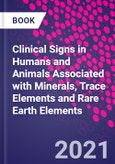This book is written for medical and veterinary researchers, clinicians, and practitioners, specifically those working with animal nutrition and animal feed health. Academics and public health scientists will also benefit from the book's information and data on rehabilitating and maintaining animal health.
Please Note: This is an On Demand product, delivery may take up to 11 working days after payment has been received.
Table of Contents
Section I: Clinical Signs and Symptoms Associated with Nutritional or Environmental Exposure to Mineral Deficiency, Excess, or Imbalances1. Observations2. Imaging3. Laboratory Findings
Section II: Individual Minerals4. Aluminium (Al)5. Antimony (Sb)6. Arsenic (As)7. Barium (Ba)8. Bismuth (Bi)9. Boron (B)10. Bromide (Br)11. Cadmium (Cd)12. Calcium (Ca)13. Chlorine (Cl)14. Chromium (Cr)15. Cobalt (Co)16. Copper (Cu)17. Fluorine (F)18. Germanium (Ge)19. Iodine (I)20. Iron (Fe)21. Lead (Pb)22. Lithium (Li)23. Magnesium (Mg)24. Manganese (Mn)25. Mercury (Hg)26. Molybdenum (Mo)27. Nickel (Ni)28. Phosphorus (P)29. Potassium (K)30. Rubidium (Rb)31. Selenium (Se)32. Silicon (Si)33. Silver (Ag)34. Sodium (Na)35. Strontium (Sr)36. Sulphur (S)37. Tin (Sn)38. Titanium (Ti)39. Tungsten (W)40. Uranium (U)41. Vanadium (V)42. Zinc (Zn)43. Rare Earth Elements (REE)
Section III: Species of Interest44. Companion Animals45. Rabbits46. Guinea Pigs and Hamsters47. Pigs48. Cattle49. Goats50. Sheep51. Pigs52. Horses53. Humans and Primates








